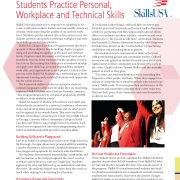Get Back to Basics: Strategies for Remote Learning in CTE
The transition to remote learning has left educators reeling. Being asked to design lessons, learn new technology, all while educating your own children and simultaneously trying to stay connected to family and friends in the middle of a pandemic is a herculean task. For career and technical education (CTE) teachers, the loss of balance is even further compounded. Why? Because CTE curriculum is often dependent on access to specialized tools and large machines
Imagine trying to teach woodworking without a lathe, or automotive without a lift. Imagine trying to teach biotechnology without a pipette, or HVAC without access to a soldering table.
It’s hard to picture — let alone do.
The truth is, CTE teachers can’t replicate the experience of hands-on learning in industry-specific lab spaces. What they can do is this:
Get back to basics.
CTE students learning in a remote environment can still learn something essential.
They can still learn how to learn.
After all, in the real world, CTE students must be able to acquire new knowledge. Today’s CTE students will soon be plumbers, electricians, cosmetologists, news anchors, entrepreneurs, engineers and doctors. They will all encounter novel situations that require deeper understanding and the independent discovery of answers.
The following strategies are designed to help CTE teachers develop curriculum, projects and lessons that guide students to take ownership of how they learn.
Think about the barriers.
- Before you design a lesson plan or an activity, pause and think about what barriers students might experience as they try to learn in a remote environment. For example, some students only have one computer at home. Plan virtual “office hours” with tons of advanced notice; offer alternative options for students to connect with you.
- If you haven’t heard from a student in a while, don’t ask why before considering the barriers. Ask yourself, “How can I design the lesson to better engage this student?” Connect with the student’s counselor for advice on outreach strategies.
- You might also develop an assignment that asks students to think about barriers they and their peers may be experiencing. Encourage them to be as honest as possible. Waking up might be a barrier if they are constantly staying up later than they would normally due to a lack of school-based scheduling.
- In remote learning environments many educators are leveraging video resources. If you choose to do so, make sure you don’t unintentionally create more barriers. Render all videos so they include closed captioning. That way students who are hearing impaired can access the learning. Captioning will also benefit students in noisy environments and enriches the learning experience for all.
Focus on the goal.
Student engagement may increase in remote learning environments if educators place a strong focus on making sure they are truly assessing the learning goal. For example, it might seem natural to ask students to write an essay response to the following question: Describe how you use a tool safely. But, if that is the only option you provide for students to demonstrate learning, what are you assessing really?
A student might know how to use the tool safely, but they might not be able to access a computer for writing, or they may not feel confident in their writing skills. What if you provided students with options for demonstrating their understanding? Can you still assess the learning goal of safety…
- If the student makes a video explaining how they would use the tool?
- If they draw a poster and submit a photograph of it?
Ask students to describe their learning goals. Consider creating an assignment that asks students to answer the following question: What are the three most important things you would like to learn with the remaining time in the school year? Use these answers to drive your unit development and activity planning.
Keep it relevant.
Students learn best when they feel the materials, tools, units or concepts are relevant or authentic. During the COVID-19 pandemic, keep it relevant by focusing on themes and tools students can access at home. Here’s an idea from Abraham Ewing, a CTE woodworking and manufacturing teacher at ConVal High School, in Peterborough, New Hampshire.
Share your home projects.
Ewing sends daily videos to students. He teaches woodworking students about estimating wood costs, project design, drawing, planning and more as he builds raised beds in his own backyard. “When I call home to talk and share what students are learning about building raised beds, most of the parents seem really excited because they want their kids to build them too.”
Ewing recommends teachers stay flexible and be ready to improvise. “For my manufacturing class I bought my own 3D printer. I use it for visuals in my class videos and I showed them how local people were using 3D printers to make masks for hospitals.”
Consider asking students what projects they are working on at home. Could students create short how-to videos detailing the projects they are working on? If they can’t work on projects at home, ask students to draw or make a video of what project they would like to do at home. How can you use students’ interests to increase engagement and make the material relevant?
If I had to craft an essential question for this time in education, it might be:
How can CTE educators design remote learning so lessons are accessible, relevant and engaging?
While the answer will look different for each teacher, and will largely depend on support, student population and subject area, the common denominator will be the need to develop strategies that bring us all back to the heart of learning.
Before working at CAST, Amanda Bastoni, Ed.D., was an accomplished CTE director and teacher with 20+ years of experience in K-12 educational leadership, journalism and business. She has a proven record of achievement including being named the 2019 New Hampshire CTE Leader of the Year. During her time in education, Amanda has focused on increasing equity and access for special populations in CTE. Email her.






